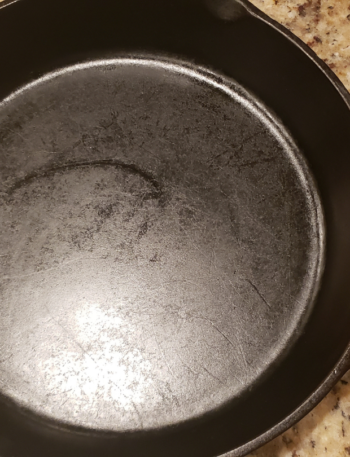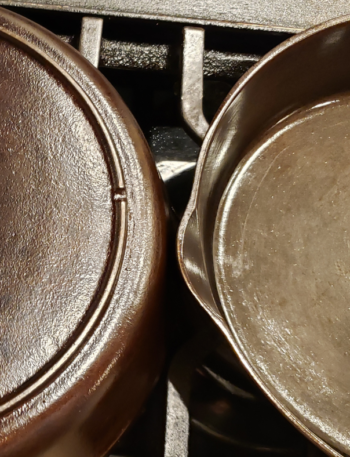Introduction
Cooking in a cast iron pan is a little different than cooking in stainless steel, and definitely different than cooking in a coated non-stick pan.
There is a simple formula to remember to cook properly in a cast iron pan. It is a hot pan, cold oil, then add food. If you don’t follow this method, food will stick and you will not have the best results.
Preparing to Cook in Cast Iron
Before you add oil to your pan, it should be hot. You will continue your non-stick results if you add oil this way. Just remember to use a hot pan and cold oil.
Many people make the mistake of adding cold oil to a cold pan and then turning on the heat. This will not work well. This will cause your food ingredients to stick, especially if they are high in starch or protein.
Get your pan to the desired temperature, add your cold (room temperature) oil or fat, and then add the ingredients.
Adding Fat to Cast Iron Pans For Cooking
What oil you use in the pan depends on your budget and type of food. You can pretty much use any oil in the pan to cook your recipe, but certain oils are better suited for certain dishes.
Butter and olive oil might be best for vegetables because you aren’t cooking them at high temperatures. Try beef fat, lard, or avocado oil for items that are cooked at higher temperatures and can’t afford to have the flavors impacted by the oil they are in.
If your cookware is seasoned properly, you need very little oil to cook. The oil type and amount really depend on what you are cooking. Starches will absorb more oil than proteins.
You can use either butter, animal fat, or cooking oil in your cast iron cookware. You can use any food-grade fat you prefer to cook with. I avoid vegetable oils, however, because they develop a gummy seasoning that is not great for cooking, I also avoid these oils except when I can’t, like when eating out.
Why You Should Oil the Bottom of Your Cast Iron
You don’t have to oil the bottom or outside like the inside. But occasionally you should rub a coating of fat on the outside and bottom just to keep it from developing any rust spots.
This helps preserve the life and look of your cast iron cookware. Remember that when you wash your cookware the water left on the pan will can cause rusting. Simply dry it off and heat it. Apply fat if necessary.
Over time, your seasoning finish will cook and wash away. Your cookware will be prone to rusting and your foods will certainly stick to the surface.
Make sure you take care of your cast iron cookware with proper re-seasoning and storage.
What Fats You Should Use to Season Your Cast Iron
I listed the oils to use in Properly Seasoning Your Cast Iron based on the fats I think are best for your pans.
These are the fats I use and the order of preference. I use what I have at the time, but will use beef fat as my go-to seasoning and reseasoning fat.
Order of fat preference to season cast iron cookware.
- Beef tallow (rendered from organ fat, around the kidneys)
- Beef fat (rendered beef muscle fat)
- Lard (rendered pork fat)
- Avocado Oil
- Grapeseed Oil
Adding Food to the Cast Iron
Preventing sticking in cast iron is probably the biggest concern of any new cast iron pan user. It is easier than one might think, but you must follow certain steps.
After placing your food in the cast iron, leave it alone for the time needed. Don’t try to move it around, just leave it alone.
Some meats will stick at first and then release when the surface is finished cooking. Moving it prematurely leaves part of it stuck to the pan.
After it releases then turn the food over and leave the other side alone. You can gently nudge it before turning to see if it is released. If it doesn’t move, give it a little time. If it moves freely or with a gentle nudge, it is ready to turn.
Avoid cooking acidic foods in your cast iron. This mainly includes acidic vegetables, fruits, and prepared foods based on vinegar. All of these items will break down the fat coating you have on your cookware’s surface.
After the acid eats this coating away, your food will stick to the surface. This completely contradicts the goal of keeping the surface seasoned.
For example, tomatoes are very acidic, so cooking tomato sauce in a cast iron pan is not the best idea. Use a porcelain-coated cast iron pan or a stainless steel pan.
As mentioned before, acidic foods should not be cooked in regular cast iron cookware. However, there is a type of cast iron that is perfect for acidic foods. That is enamel-coated cast iron.
With enamel-coated cast iron, you have a lot of the benefits of cast iron with the protection of the enamel. With the enamel coating, you don’t have to worry about the seasoning of the cookware.
You do lose some of the benefits of cast iron, but the main two features that remain are great heat distribution and excellent heat retention. See Cooking Foods in Cast Iron posts
Steps After Cooking is Complete
Right after cooking, let the pan rest on the stove until it cools down low enough that you can touch the handle and pan without burning yourself. It does not have to be cool enough to handle it without assistance.
After it has cooled down a bit, you can move it to the sink to clean. You do not want to splash water on a super hot pan. It can warp, crack, or cause enough steam to burn you. The best thing is the let it cool while you are eating and clean it afterward.
Conclusion
It is easy to cook in cast iron, you just have to follow a few simple rules. You may also want to check out the Wagner Griswold Society for information on vintage pieces
Discover more from In The Kitchen With Vic
Subscribe to get the latest posts sent to your email.






